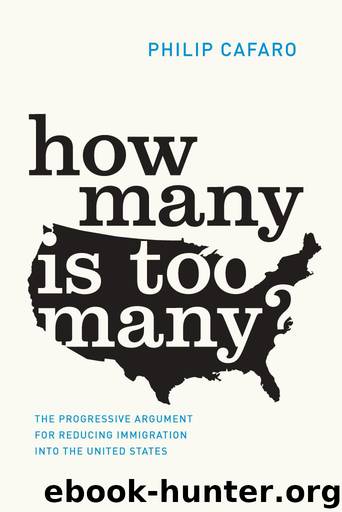How Many Is Too Many?: The Progressive Argument for Reducing Immigration into the United States (Chicago Studies in American Politics) by Philip Cafaro

Author:Philip Cafaro
Language: eng
Format: mobi
ISBN: 9780226197623
Publisher: University of Chicago Press
Published: 2015-02-06T00:00:00+00:00
Grappling with Growth
There is a curious disconnect in climate change discourse between explanations of its causes and discussions of possible solutions. On the one hand, it is widely acknowledged that the primary causes of global climate change are unremitting economic and demographic growth. As the IPCC’s Fourth Assessment Report succinctly put it: “[increased] GDP/per capita and population growth were the main drivers of the increase in global emissions during the last three decades of the twentieth century. . . . At the global scale, declining carbon and energy intensities have been unable to offset income effects and population growth and, consequently, carbon emissions have risen.”19 On the other hand, most proposals for climate change mitigation take growth for granted and focus on technical efforts to ameliorate its negative effects.
Climate scientists speak more formally of the “Kaya Identity” (developed by Japanese energy economist Yoichi Kaya): the four primary factors that determine overall greenhouse gas emissions. They are economic growth per capita, total population, energy used to generate each unit of GDP, and greenhouse gases generated per unit of energy. In recent decades improvements in energy and carbon efficiency have been overwhelmed by increases in population and wealth. Here are the numbers, again according to the IPCC: “The global average growth rate of CO2 emissions between 1970 and 2004 of 1.9% per year is the result of the following annual growth rates:
population +1.6%,
GDP/per capita +1.8%,
energy-intensity (total primary energy supply [TPES] per unit of GDP) −1.2%,
and carbon-intensity (CO2 emissions per unit of TPES) −0.2%.”20
Crucially, the IPCC’s projections for the next several decades see a continuation of these trends. More people living more affluently mean that under “business as usual,” greenhouse gas emissions will probably double sometime during the next half century, despite expected technical efficiency improvements.21 If we allow this to occur, it will almost surely lock in global temperature increases of more than 3.6°F over pre-industrial levels, exceeding the threshold beyond which scientists speak of potentially catastrophic climate change.
A reasonable person reading the scientific literature on climate change would likely conclude that humanity is bumping up against physical and ecological limits right now. Given the possible dangers, a prudent response might be: “Wow, this is going to be hard! We need to start working on this problem with all the tools at our disposal. Increasing energy and carbon efficiency, to be sure. But also decreasing consumption, reining in the pursuit of affluence, and reducing human populations now, slowly and humanely, before nature culls our numbers abruptly and harshly. Maybe in the future we can grow like gangbusters again. But for now people need to make fewer demands on nature. After all, our situation is unprecedented—over 7 billion people, most living or aspiring to live in modern, industrialized economies—and there is good evidence that we are already in overshoot mode.” Such convictions would only be strengthened by considering further evidence of global ecological degradation from the Millennium Ecosystem Assessment, including the depletion of important ocean fisheries, accelerating soil erosion, ongoing species extinctions throughout the world, the growth of immense “dead zones” at the mouths of many great rivers, and more.
Download
This site does not store any files on its server. We only index and link to content provided by other sites. Please contact the content providers to delete copyright contents if any and email us, we'll remove relevant links or contents immediately.
| Anthropology | Archaeology |
| Philosophy | Politics & Government |
| Social Sciences | Sociology |
| Women's Studies |
The Secret History by Donna Tartt(18215)
The Social Justice Warrior Handbook by Lisa De Pasquale(11960)
Thirteen Reasons Why by Jay Asher(8468)
This Is How You Lose Her by Junot Diaz(6458)
Weapons of Math Destruction by Cathy O'Neil(5848)
Zero to One by Peter Thiel(5505)
Beartown by Fredrik Backman(5371)
The Myth of the Strong Leader by Archie Brown(5246)
The Fire Next Time by James Baldwin(5027)
How Democracies Die by Steven Levitsky & Daniel Ziblatt(4969)
Promise Me, Dad by Joe Biden(4914)
Stone's Rules by Roger Stone(4869)
100 Deadly Skills by Clint Emerson(4699)
A Higher Loyalty: Truth, Lies, and Leadership by James Comey(4562)
Rise and Kill First by Ronen Bergman(4551)
Secrecy World by Jake Bernstein(4404)
The David Icke Guide to the Global Conspiracy (and how to end it) by David Icke(4389)
The Farm by Tom Rob Smith(4331)
The Doomsday Machine by Daniel Ellsberg(4252)
